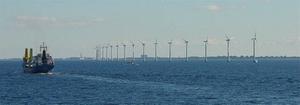EnergyJapan hopes off-shore wind turbines can replace shut-down nukes
Japan inaugurated a floating offshore wind turbine on Monday, symbolizing the country’s effort to reduce its dependency on nuclear energy and fossil fuels and shift to renewable energy sources. The floating platform is anchored thirteen miles offshore from the Fukushima Daiichi nuclear power plant, which has been out of commission since the reactor’s meltdown disasterof March 2011. The platform is anchored to the seabed 400 feet below surface. It is the first project of its kind in Japan, and it aims to show that the country can exploit the country’s powerful offshore winds to create a sustainable energy source.

Danish offshore windfarm near Copenhagen // Source: commons.wikimedia.org
Japan inaugurated a floating offshore wind turbine on Monday, symbolizing the country’s effort to reduce its dependency on nuclear energy and fossil fuels and shift to renewable energy sources. The floating platform is anchored thirteen miles offshore from the Fukushima Daiichi nuclear power plant, which has been out of commission since the reactor’s meltdown disaster of March 2011.
The Los Angeles Times reports that the platform is anchored to the seabed 400 feet below surface. It is the first project of its kind in Japan, and it aims to show that the country can exploit the country’s powerful offshore winds to create a sustainable energy source.
“I believe that the Fukushima (wind) project will help the Fukushima region and Japan as a whole move toward more use of renewable energy,” Takeshi Ishihara, a civil engineer at the University of Tokyo and leader of the Fukushima wind farm project, told the Japan Daily Press.
The 2,000 Kilowatt wind turbine transmits electricity to about 600 households through an underwater cable operated by Tohoku Electric Power Co. The project is a collaboration between the public and the private sector, and is led by the Economy, Trade and Industry ministry. It will include the University of Tokyo and ten major industrial enterprises.
Next year the group plans to add two floating turbines, each capable of generating 7,000 Kw. Japan Daily Press reports that Japan’s wind energy could potentially generate 1,570 Gigawatts, five times the current national electricity output. The potential of wind turbines supports the opponents of nuclear power in Japan. Japan’s fifty nuclear reactors were shut down or are inoperable following the Fukushima disaster. Electrical utilities have asked the government to allow fourteen reactors to begin operation following improvements and adoption of new regulations, but public opposition to nuclear operations is strong.
Officials consider the floating turbine as an opportunity for nuclear industry workers in the region to build new careers in renewable energy. “Fukushima is making a stride toward the future step by step,” Fukushima prefecture Governor Yuhei Sato told industry and political leaders gathered for an opening ceremony in the port of Iwaki. “Floating offshore wind is a symbol of such a future.”
The project will undergo an environmental impact assessment to determine its potential effects on Japan’s vital fisheries industry. Broadcaster NHK reported that the head of a local fisheries cooperative, Hiroyuki Sato, said that trawling operations would be challenged by excessive increase of floating turbines and the heavy chains and anchors used to position them over the seabed.
